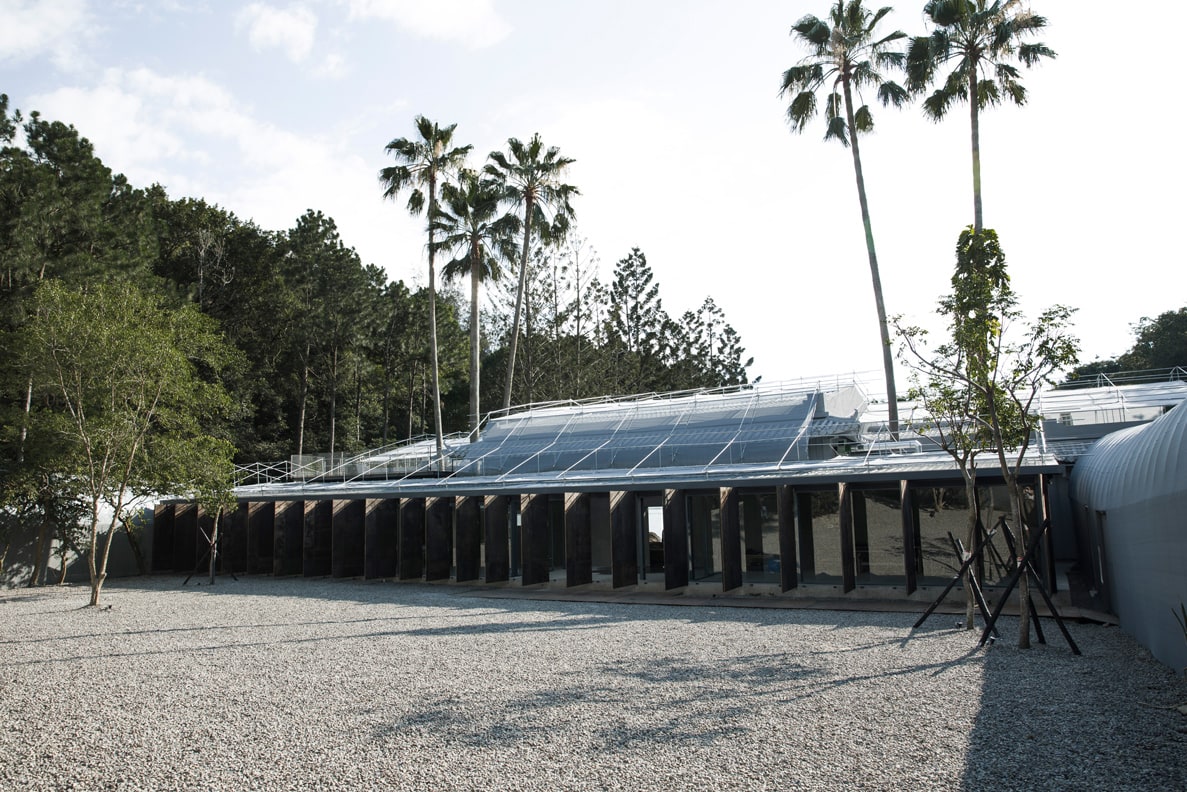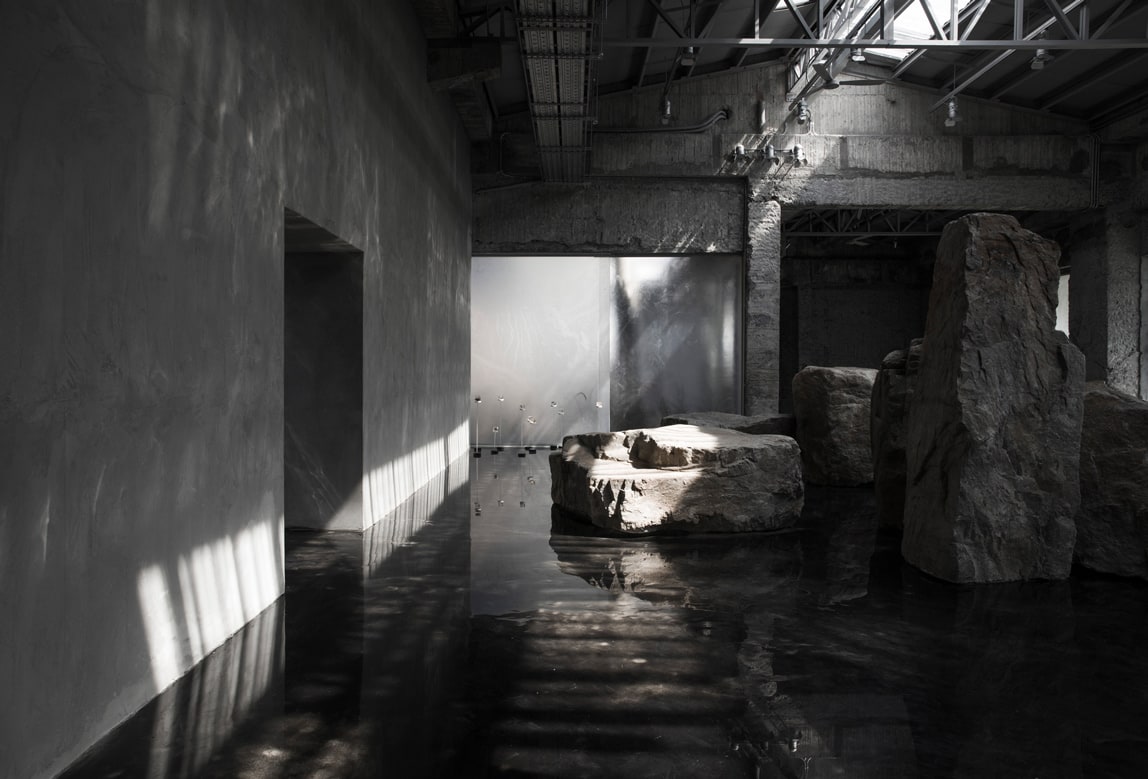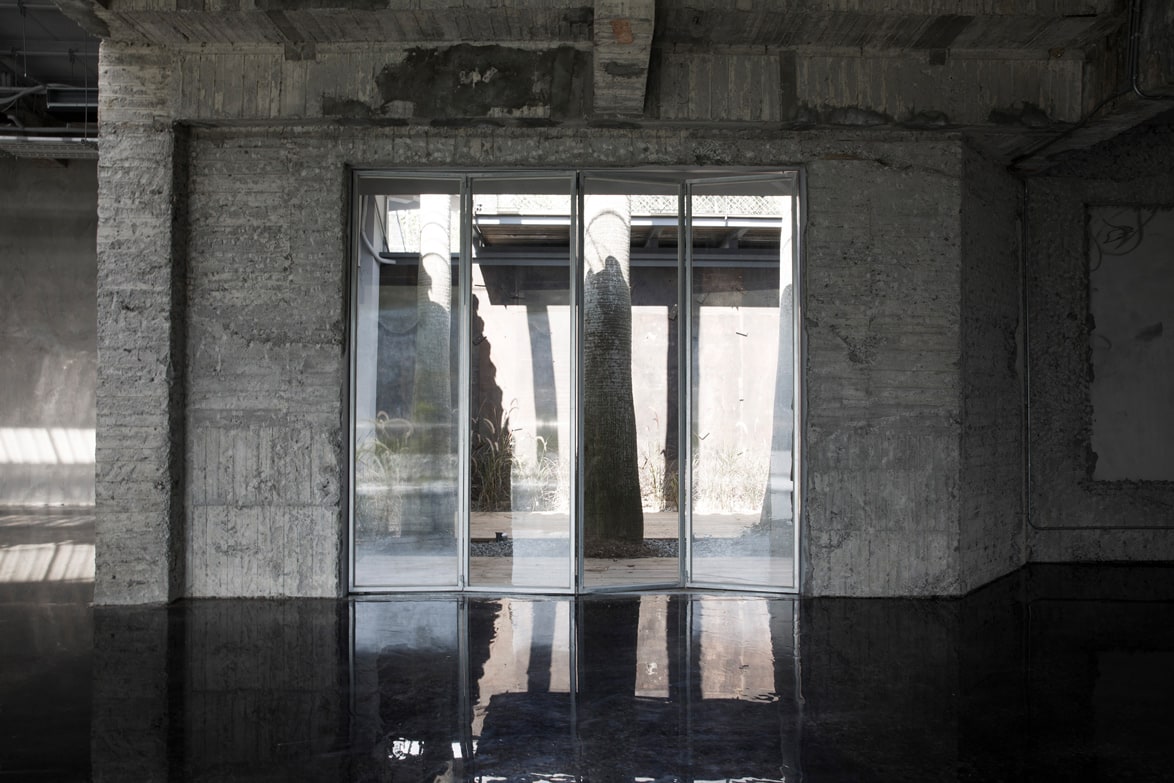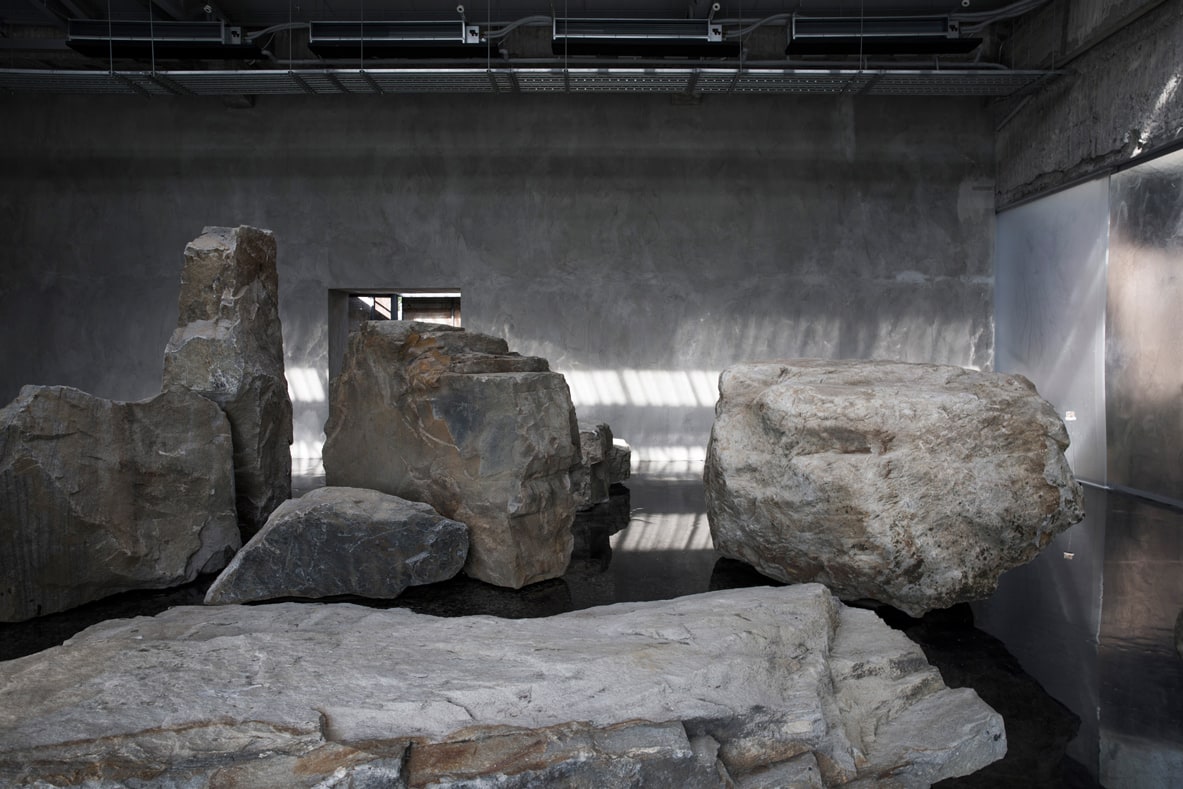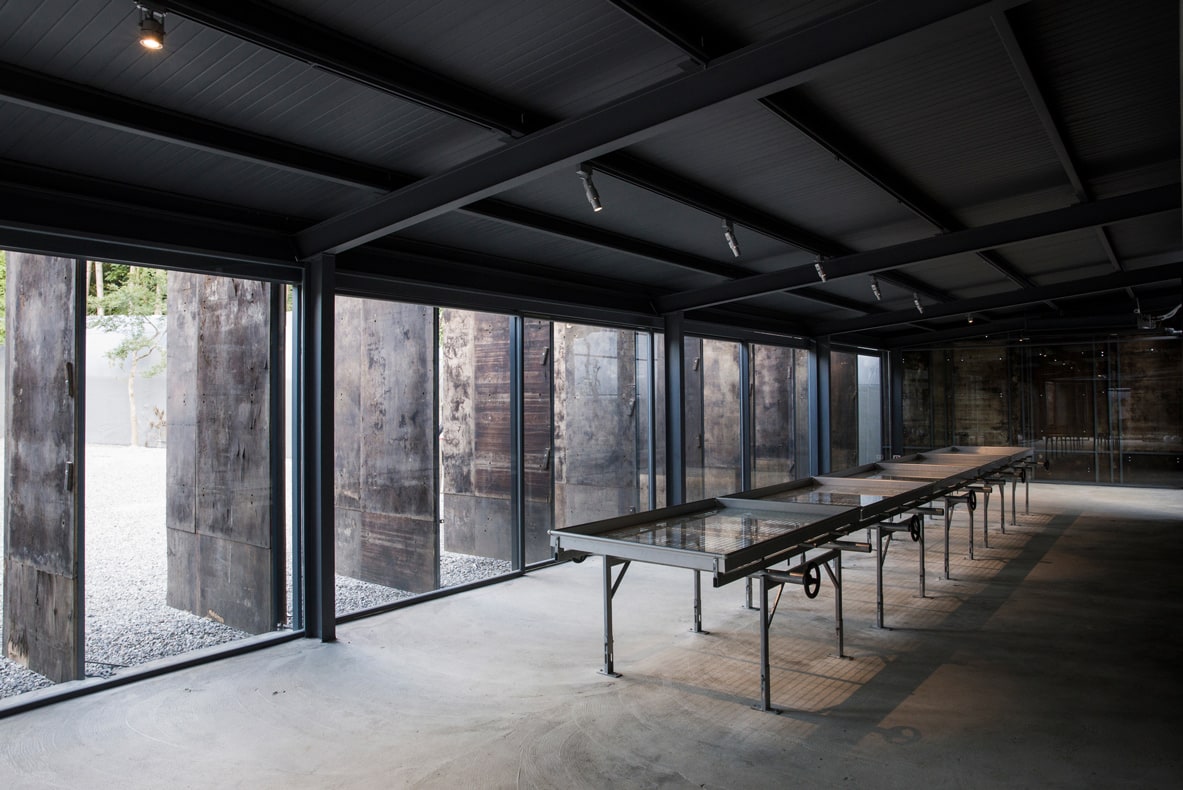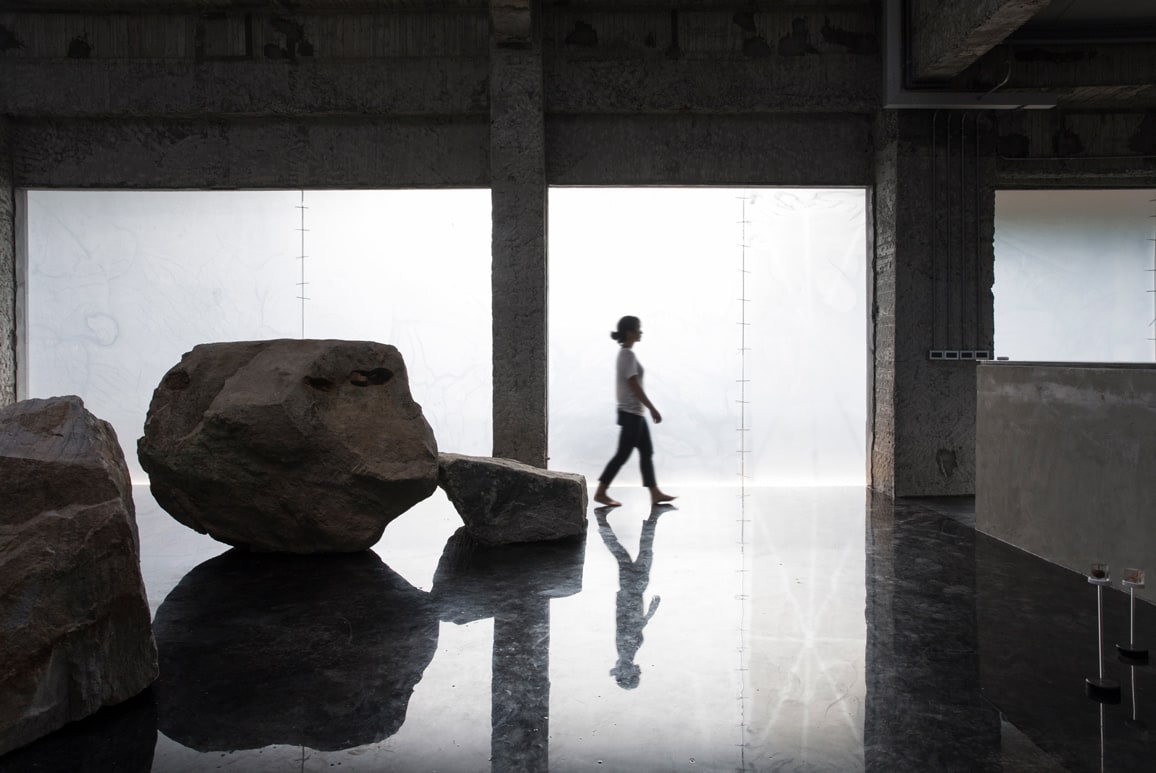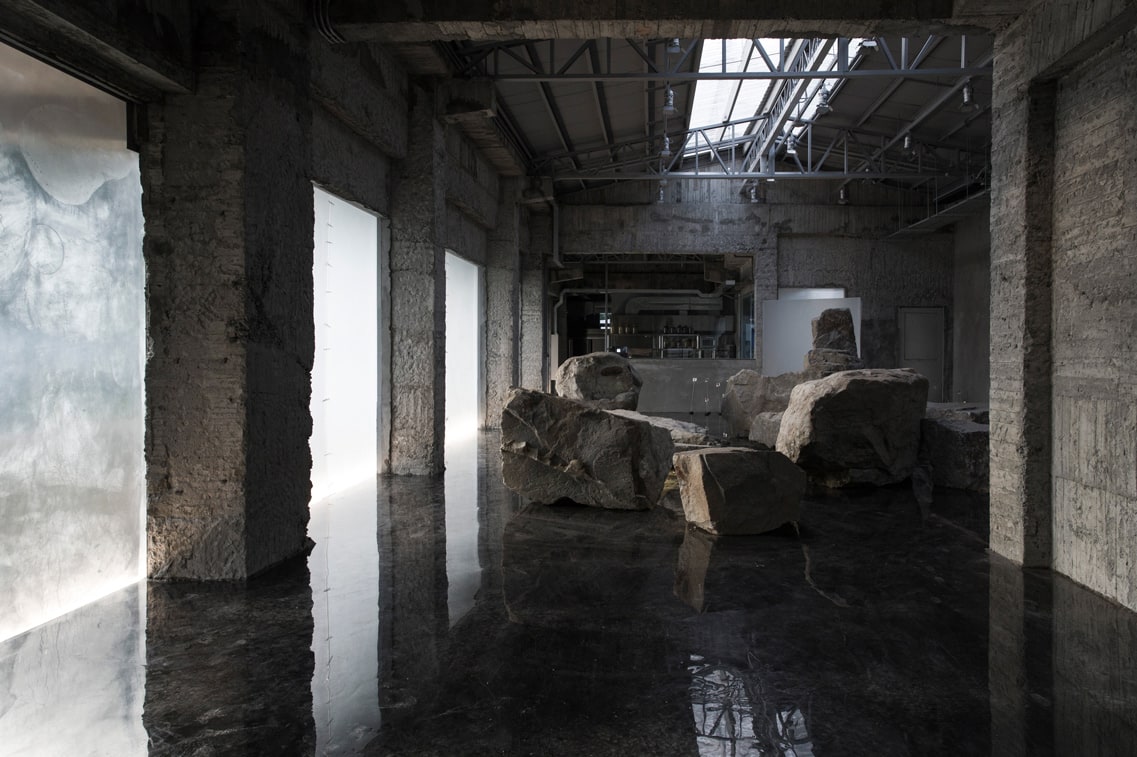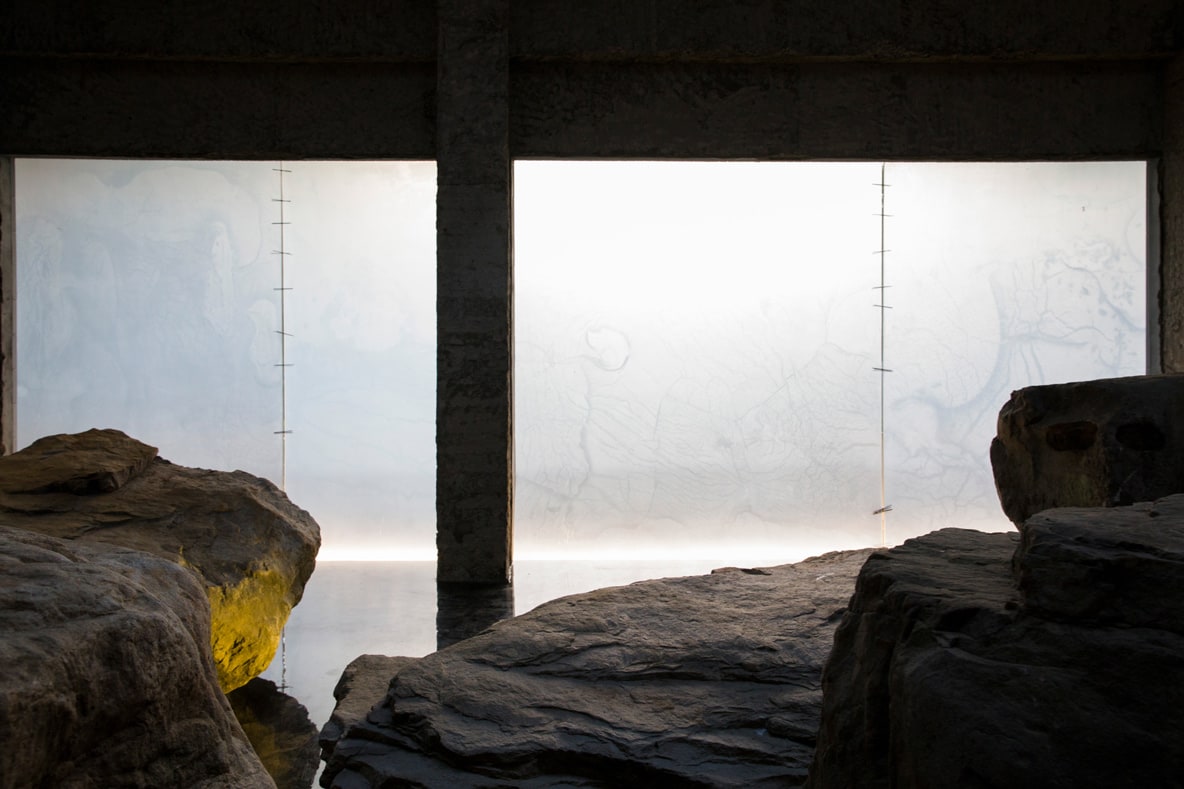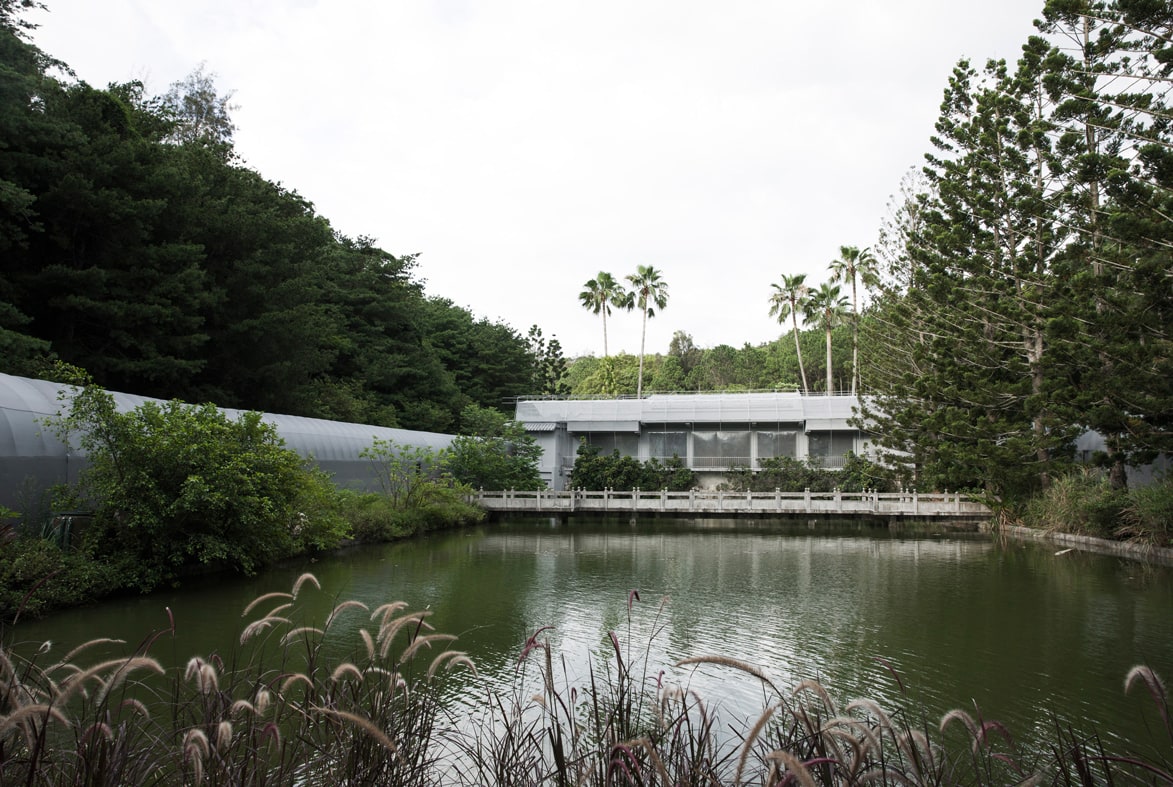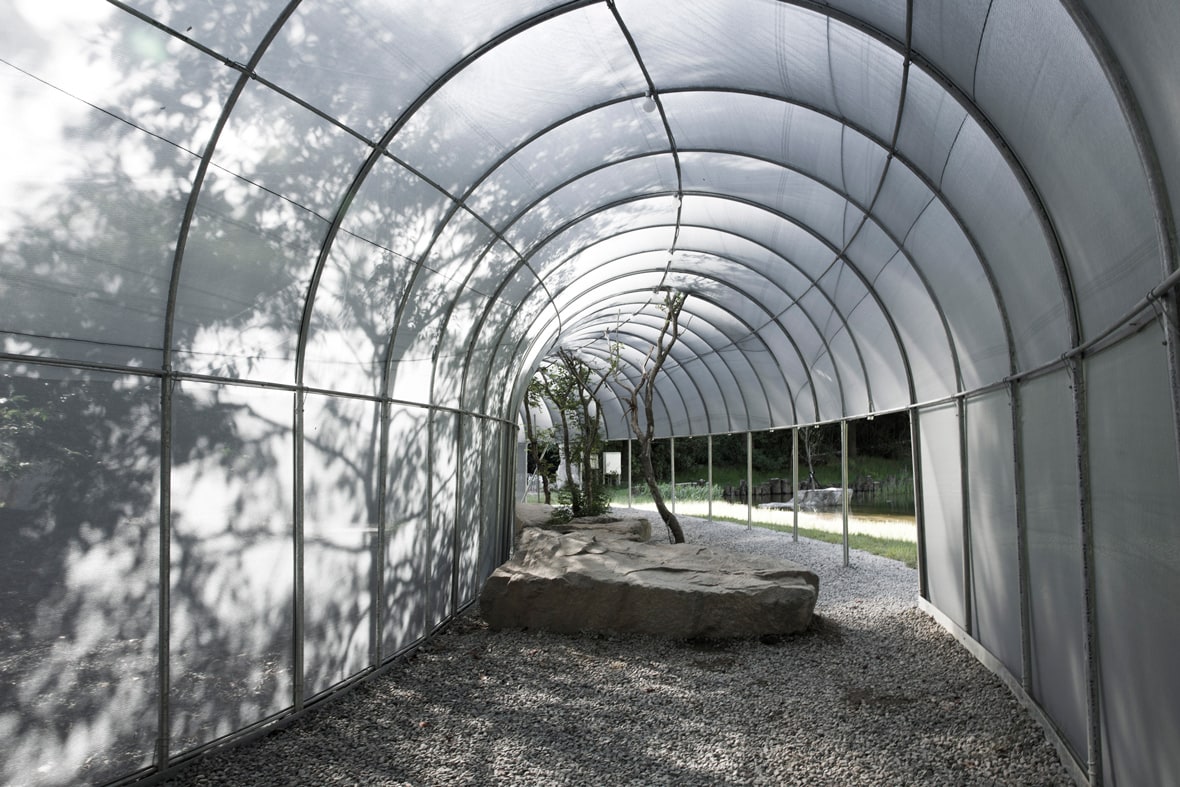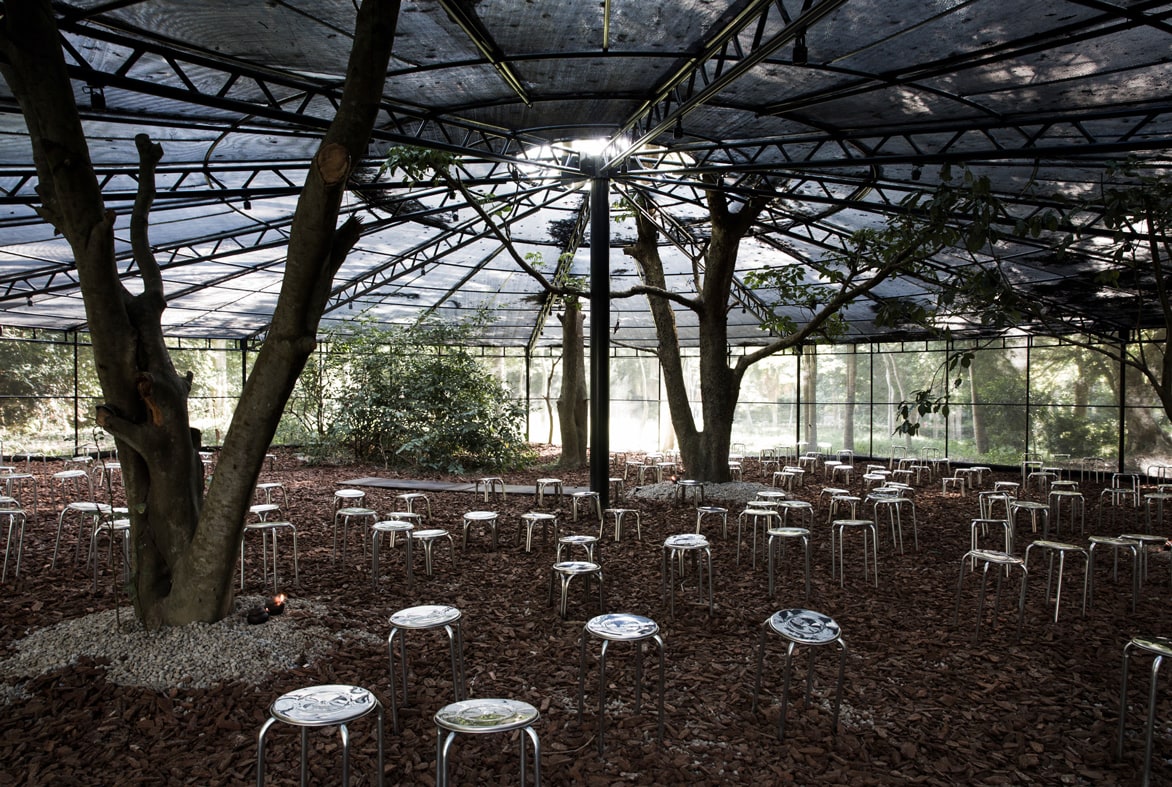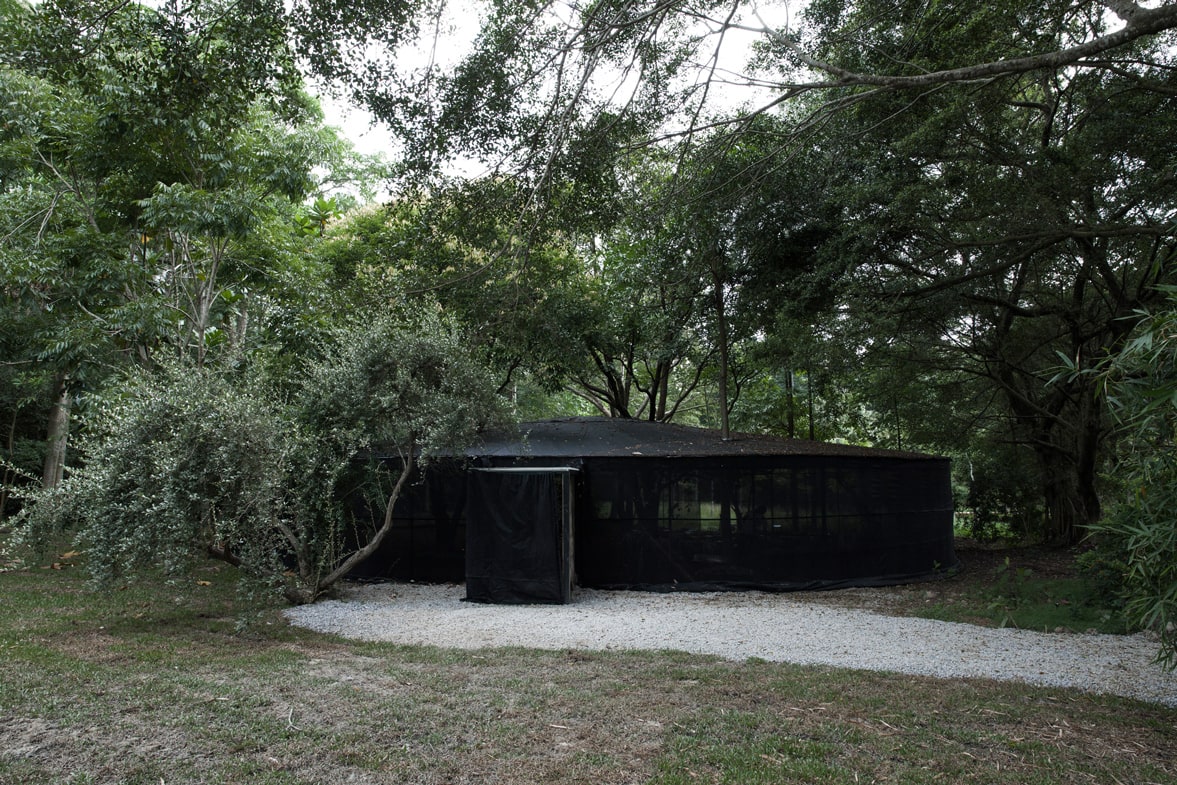디보오에
제인 아키텍츠_ 디보오에제인
자연과 인간의 접점을 구하다
디보오에 제인은 디보오에 제인 아키텍츠의 대표다. 그는 팔라우에서
자랐고 국제학교를 다녔다. 2003년 대만 타이베이에 디보오에 제인 아키텍츠를 설립한 뒤 발리, 인도네시아, 대만 등에서 활동 중이다. 2014년에는 '슈슈· 원시적
감각의 실험실’을 설립했고 대만 시지안대학교에 출강 중이다.
디보오에 제인(제인): 슈슈는 타이베이 산에 대한 연구 프로젝트다. ‘자연 속에서 배우는 영역’을 주제로 식물학자, 전통 의학 연구자, 원주민, 기후 과학자, 조향사, 심령술사, 요가 교사 등 다양한 전문가들이 연구에 참여했고, 이를 바탕으로 설계를 진행했다. 다시 말해 슈슈는 더 포레스트 빅에 앞선 기초 개념의 시작점이다. 슈슈의 결과물과 유사한 재료와 프로그램을 더 포레스트 빅에 활용했기 때문에 두 프로젝트의 연관성이 당연히 크게 느껴진다. 더 포레스트 빅은 지리적 특성상, 인간과 자연의 교차점에 있어 둘 사이의 경험과 지식을 잇는 역할을 한다. 이전에 존재했던 자연 속에 버려진 건물과 장비들이 독특한 포스트모던 풍경을 만들어낸다는 특징이 있다.
제인: 자연의 숲을 인간의 활동, 시설, 건물과 분리하는 것을 디자인 원칙으로 삼았다. 그래서 300m의 원형 동선을 비닐하우스 구조로 덮어 자연과 인간의 경계를 명확하게 정의했고, 또한 이러한 방식은 관람자를 보호하는 데에도 유용하다. 사람은 숲의 영역과 일정한 거리를 유지하고 자연은 건축과 같은 요소에 방해받지 않도록 했다. 숲은 대만 국토의 60%를 차지한다. 사람들이 이 프로젝트를 통해 숲과 공존하는 법을 배우기를 바랐고 자연에 대한 겸손하고 공손한 태도를 일깨우기를 희망하면서 프로젝트를 진행했다.
제인: 내 경험상 혼자 숲 속을 걷는 것은 일종의 명상이고, 천연 피톤치드는 몸과 마음을 안정시켜준다. 그래서 길은 사람만 지나갈 수 있는 너비로 계획했다. 대지 면적이 아주 넓기 때문에 다른 사람을 만나는 경우는 극히 드물다. 혼자서 오롯이 시간을 보낼 수 있다. 10분간 이 작은 길을 따라 가면 ‘그린 하우스’라는 300m의 통로를 지나게 되는데 이곳은 연결 통로이자 온실이다. 이곳을 지나면 생태 연못, 키 큰 나무 여러 그루, 트리 하우스가 있고 버려진 수족관을 이용해 조성한 ‘본관’이 나온다. 본래의 모습을 보여주기 위해 오래된 페인트를 벗겨내고 콘크리트 표면을 복원했다.
제인: 본관은 오래전부터 존재했던 폐허였고, 매립 연못은 실제로 물이 있던 곳이었다. 깨끗하지도 않고 냄새도 좋지 않아 모든 건물을 그물로 씌웠다. 더불어 시선을 자연스럽게 흐리게 만드는 장치로 리아나 덩굴나무로 지붕을 덮었다. 이러한 재료의 사용으로 주변부와 건물과의 경계를 부드럽고 모호하게 했다. 그리고 이 재료와 함께 수증기를 공중에 분사하는 시스템을 작동하여 실내 공간을 더 시원하게 유지하고 있다. 밤에는 터널을 따라 설치된 조명들이 공간의 분위기를 바꾼다.
제인: 이곳을 경험하는 사람들에게 이곳의 소리나 인공조명, 재료에서 느껴지는 광택 등을 통해 환상적인 분위기가 전달된다. 그것이 재료가 주는 특이점이라고 생각하는데 공간 전체를 구성하는 아연도금 구조체와 광택이 있는 재료가 그러한 효과를 만든다. 이 공간을 따라 돌다 보면 자연스럽게 공간과 재료가 주는 독특한 경험을 하게 된다.
박: 프로젝트를 시작할 당시 대지의 상황은 어떠했나? 기존 건물의 구조물에 새롭게 가설건물을 연결시킬 때 고려한 사항들은 무엇인가?
예를 들어 중간 다리는 왜 유지하기로 했나?
제인: 40년 전 이곳은 10만m2 규모의 놀이동산이었다. 회전목마, 롤러코스터, 거북이 다리 등 많은 시설과 놀이 기구 그리고 희한한 물건과 수족관이 현장에 남겨져 있었다. 나는 옛것에 대한 호기심과 추억으로 일부 오브제를 보존하고 있었고, 이를 재조합 하여 새로운 디자인으로 만들었다. 이러한 접근은 주변 자연과의 대비를 만들고, 사람들은 경험해보지 못했던 것들을 의식하게 된다. 본관은 수족관이었고, 숲 극장은 놀이동산의 호박 온실이었으니 말이다. 숲 극장에서는 원래 있던 수목들을 옮겨 심고 상부에 구멍을 뚫어 빛이 들어오게 바꾸어 나무가 온전하게 자랄 수 있도록 계획했다. 바닥엔 소나무껍질을 두어 외부에서의 감각적 경험을 그대로 연결하고자 했다.
제인: 대만의 산지는 습하고 비가 많이 내리고 태풍으로 인한 집중호우까지 더해져 농작물이 병해충 피해를 자주 입고 피해도 크다. 이러한 기후적 조건 때문에 대만의 농업시설에서 비닐하우스로 식물을 보호하는 방법은 아주 보편적이다. 익숙한 재료들이 이곳만의 독특한 분위기를 만들어낸다고 생각한다.
제인: 어떤 활동이나 프로그램이든, 이곳이 사람들에게 평화롭고 고요한 순간을 제공한다면 그것 만으로 큰 성취가 될 것 같다. 안정된 공간에서 주변의 익숙한 자연을 다시 바라보고 경험하게 하는 것이 이번 프로젝트의 가장 중요한 방향 중 하나였다. 그리고 자연, 식물, 곤충에 대해 더 많이 배울 수 있도록 정원을 적당히 정돈되지 않게 조성했다. 자연에 가까운 이곳은 창조적인 경험을 제공하는 ‘자연 공방’이나 ‘숲속 생태 실험학교’ 같은 역할도 한다. 비일상적인 공간들로 구성된 짧은 여정을 상상하며 계획했다. 사람들이 이곳을 경험하며 ‘자연 교실’과 같은 느낌을 받으면 좋겠다.
제인: 본관의 주요 기능은 레스토랑이다. 사람들이 멋진 연못을 옆에 두고 바위에 앉아 야외에서 피크닉을 하는 모습을 상상하며 설계했다. 그래서 우리는 현장에 있는 거대한 돌들을 모아 의자, 탁자, 설치물, 조경 등에 사용했다. 또한 시각적인 부분에 대해서도 투명하게 개방하기보다는 태양 빛을 극적으로 받아서 표현하도록 수제로 제작한 부유스름한 젖빛유리를 설치했다. 이곳에 오는 사람들이 단순한 마음에 더 집중할 수 있도록 의도했다.
제인: 성스럽고 차분한 분위기를 경험할 수 있는 곳이 있다면 도시 생활에 많은 도움이 될 것 같다. 우리는 도시의 하루하루를 무감각하게 살아가고 있다. 환경이 바뀌면 그 환경에 적응하기 위해 몸이 반응할 것이다. 그런 몸의 감각과 반응이 이 곳에서의 경험을 더욱 강하게 만들어줄 것이라고 생각했다. 이런 경험을 하고 다시 도시의 일상으로 돌아간다면 이미 그 사람은 다른 사람으로 바뀌어 있다고 생각한다. 그렇기 때문에 도시에서의 생활과 이 곳에서의 경험은 다시 하나로 연결될 수 있다.
제인: 모든 활동과 프로그램이 중단된 상태다. 어떻게 보면 그것이 자연의 섭리인 것 같다. 팬데믹이 끝나기를 기다렸다가 다시 처음에 계획했던 프로그램과 경험을 제공할 것이다.
제인: 전시를 계획하고 구성하여 선보이는 일련의 개념은 우리의 건축적 개념과 이어진다. 건축 프로젝트를 할 때와 마찬가지로, 이번 전시도 몸의 감각과 고요함의 아름다움을 느낄 수 있는 경험이 되길 바라며 작업했다. 우리는 이 프로젝트를 통해 인간과 자연 사이의 상호작용의 효과를 탐구했다.
제인: 그렇다면 정말 좋겠다! 사람과 자연과 기술 사이의 균형을 맞추거나 다시 생각하려는 우리의 모든 노력은 자연을 마주하는 데 주요한 역할을 할 것이다.
Divooe Zein Architects_ Divooe Zein
REDISCOVERING THE INTERFACE BETWEEN THE HUMAN AND THE NONHUMAN
Divooe Zein is the director
of Divooe Zein Architects. He was raised in the Palau islands and studied at
the international school SDA. After engaging in architectural practice for some
years, he established Divooe Zein Architects in Taipei. In 2003 he began the
journey and a range of field studies back and forth between the Balinese
islands in Indonesia and Taiwan, to which he still commits his energies today.
In 2014, he established the Siu Siu Lab of Primitive Senses in Taipei, and
began teaching work in the Shih Chien University Department of Architecture in
Taiwan.
Divooe Zein (Zein): The siu siu was a research plan initiated by our team in the Taipei Mountains. Centered on the theme of a 'learning domain in nature', various elements of the project were organized with the help of a wide range of experts, including botanists, traditional medical researchers, indigenous peoples, climatologists, perfumers, spiritualists, and yogis. In this sense, siu siu is the predecessor and the source of the conception of The Forest BIG. To this effect, we used similar materials and programs derived from siu siu that could be readily incorporated into this new project.
Zein: The foremost aim was to separate the forest from human activities, facilities, and buildings. As a result, we tried to render the 300m circulation as a circular net greenhouse structure to define a clear boundary between nature and humans. This also acts as a protection system for visitors. I believe that people should maintain an appropriate distance from nature and not create disruptions, much like the architecture we find in the forest area.
Zein: In my experience, walking alone into the woods, even if only for a few minutes, is like meditation and helps our mind and body grow calm through natural phytoncide. Therefore, the width of the path was designed only for individuals. During this 10-minute walk, one will encounter an eco-pond, a tree house, and vast tree areas all arranged along this little path.
Zein: The main event space building was a ruin that has long existed. We found that the pond is of a reclaimed water system. It does not look always clean or smell pleasant. As such, we covered the building with netted mesh, and we complemented this with Lianas covering the rooftop to create a natural blurred effect.
Zein: The way humans receive messages through hearing and lighting, of an illusion from the glow, leads to irrational thinking. I think that this is what prompts your sense of singularity presented by the materials in the galvanized structure and the glossiness that makes up the entire space. Walking around, one will bear witness to the distinctiveness of the space and its materials.
Zein: The Forest BIG was an IO-hectare amusement park 40 years ago. Lots of entertainment facilities and play sets had been left behind, such as a carousel, a roller coaster, and a turtle pond bridge as well as many strange objects and an aquarium. My curiosity and nostalgia asked me to preserve some of these objects and to devise absurd combinations to create new designs, which were like archaeological traces of that former time in the site's history. This approach, contrasting the design with the surrounding landscape, creates an experience that will otherwise never be consciously understood. The main building became the aquarium, and the forest theatre was converted into the amusement park pumpkin greenhouse. The original trees were transplanted, and a hole was vacated in the canopy to allow light in so that they will grow. Even the more sensory elements were considered as the pine bark floor connects the outside experience to the interior space.
Zein: Taiwan's mountain climate is humid and rainy, making it difficult to control pests and crop diseases. In addition, the heavy rainfall brought about by typhoons causes further crop damage. Therefore, a preventive system of plant shelters assembled with nets is the most common agriculture construction in Taiwan. I believe that these familiar materials create an atmosphere unique to this location.
Zein: If this place can provide visitors with a moment of peace and serenity, no matter the type of activity or program, that would be a great achievement. Viewing and feeling through nature in a serene space is one of the most important aims behind this project. I intended to provide an experience of rediscovery, exploring familiar natural elements in a safe environment. To a certain extent, it also serves as a 'nature workshop' or a 'forest ecology school' that provides creative experiences with real, untreated gardens to help educate citizens on nature, plants, and insects. To provide visitors with a partially comfortable experience, we imagined short journeys between several unique interior spaces that add up to around 600m2. Visitors appeared to want the sense of a 'nature classroom' throughout the project.
Zein: The primary function of the main building is the restaurant. It was designed to be a wholesome image of people picnicking in this wild sitting by the rock next to a stream. For this, we collected the huge rocks on site and gathered them for use as chairs, tables, and land art, while the frosted glass of a low, sacred lighting, instead of a simple transparent pane, was installed. I wanted the visitors to focus more on their deepest emotional connections with these spaces.
Zein: If we could create a place of serenity and calm in an urban area, that would benefit those living in the city. We live absent-mindedly in our everyday city life. However, when the environment changes, the body responds to adapt to our environment. The sensations and reactions of the body would strengthen and deepen our experience of place. When one returns to the daily life of the city after this experience, they already would have experienced a change of self. Therefore, city life and experiences here will form a connection. It was hoped that those calm, reverent, and compassionate feelings could be communicated and felt through the programs here.
Park: I am curious as to how these programs
have been maintained during the pandemic. The scale suggests that it may be
suitable for isolation and social distancing, but it must have affected the
number of admissions.
Zein: We have suspended all activities as per the rules after the pandemic. In a way, it seems to be the providence of nature. We'll soon be back with our originally scheduled programs and events.
Zein: The concept behind the projects we designed, organized, and exhibited at the Venice Biennale was consistent with our guiding architectural concepts. I hope that the atmosphere of the exhibition helped people to experience the glow of bodily sensations and a sense of serenity. Fundamentally, we started this project by exploring the effects of interactions between humans and nature. As such, the project exhibited at the Venice Biennale closely integrates into our usual work and concepts.
Zein: That would be wonderful! Any effort or attempt to balance or rethink the relationship between our skills, mind, and technology would be critical in terms of engaging with nature in the city.
자연과 인간의 접점을 구하다
디보오에 제인은 디보오에 제인 아키텍츠의 대표다. 그는 팔라우에서
자랐고 국제학교를 다녔다. 2003년 대만 타이베이에 디보오에 제인 아키텍츠를 설립한 뒤 발리, 인도네시아, 대만 등에서 활동 중이다. 2014년에는 '슈슈· 원시적
감각의 실험실’을 설립했고 대만 시지안대학교에 출강 중이다.
마지막 인터뷰에는 대만 타이베이를 기반으로 활동중인 디보오에 제인 아키텍츠다.
대표 디보오에 제인은 팔라우에서 유년 시절을 보내고 현재는 발리, 인도네시아, 대만 등에서 다양한 프로젝트를 진행하고 있다. 나는 그의 프로젝트에서
앞선 인터뷰이들과는 다른 접근방식과 감수성을 발견할 수 있었다. 특히 자연을 어떻게 이해하고 받아들이는지에
대해 여러 궁금증이 생겼고, 그에게 전화를 걸었다.
박창현(박): 디보오에 제인 아키텍츠의 프로젝트들을 보면, 자연과 인공이 만나는 접점에 관심이 많은 것 같다. 여러 프로젝트가 있지만, 전화로 진행하는 인터뷰인 만큼 오늘은 ‘더 포레스트 빅’(2018)에 집중해보고자 한다. 대만 먀오리에 위치한 샹그릴라 공원 남쪽에 버려진 단지를 전시 공간, 교육시설 등으로 리노베이션한 프로젝트다. 이전 작업인 ‘슈슈: 원시적 감각의 실험실’(2014, 이하 슈슈)과 비교하면, 반원 형태의 공간을 사용했다는 점에서 유사하지만, 그보다 더 정적인 분위기가 느껴진다.
디보오에 제인(제인): 슈슈는 타이베이 산에 대한 연구 프로젝트다. ‘자연 속에서 배우는 영역’을 주제로 식물학자, 전통 의학 연구자, 원주민, 기후 과학자, 조향사, 심령술사, 요가 교사 등 다양한 전문가들이 연구에 참여했고, 이를 바탕으로 설계를 진행했다. 다시 말해 슈슈는 더 포레스트 빅에 앞선 기초 개념의 시작점이다. 슈슈의 결과물과 유사한 재료와 프로그램을 더 포레스트 빅에 활용했기 때문에 두 프로젝트의 연관성이 당연히 크게 느껴진다. 더 포레스트 빅은 지리적 특성상, 인간과 자연의 교차점에 있어 둘 사이의 경험과 지식을 잇는 역할을 한다. 이전에 존재했던 자연 속에 버려진 건물과 장비들이 독특한 포스트모던 풍경을 만들어낸다는 특징이 있다.
박: 이 프로젝트를 처음 봤을 때 인위적이지 않고 자연스럽다는 느낌을 받았다. 자연, 기존 건물, 주변을 분리하는 방법과 동선을 계획하는 데 어떤 점을 중요하게 고려했나? 이곳을 경험하는 사람들에게 자연을 어떻게 전달하고자 했는가?
제인: 자연의 숲을 인간의 활동, 시설, 건물과 분리하는 것을 디자인 원칙으로 삼았다. 그래서 300m의 원형 동선을 비닐하우스 구조로 덮어 자연과 인간의 경계를 명확하게 정의했고, 또한 이러한 방식은 관람자를 보호하는 데에도 유용하다. 사람은 숲의 영역과 일정한 거리를 유지하고 자연은 건축과 같은 요소에 방해받지 않도록 했다. 숲은 대만 국토의 60%를 차지한다. 사람들이 이 프로젝트를 통해 숲과 공존하는 법을 배우기를 바랐고 자연에 대한 겸손하고 공손한 태도를 일깨우기를 희망하면서 프로젝트를 진행했다.
박: 더 포레스트 빅에 도달하기까지의 과정도 중요할 듯하다. 입구부터 10분 넘게 걸어 가야 건물에 다다르게 되는데, 이러한 전환의 시간은 의도적으로 계획된 것 같다.
제인: 내 경험상 혼자 숲 속을 걷는 것은 일종의 명상이고, 천연 피톤치드는 몸과 마음을 안정시켜준다. 그래서 길은 사람만 지나갈 수 있는 너비로 계획했다. 대지 면적이 아주 넓기 때문에 다른 사람을 만나는 경우는 극히 드물다. 혼자서 오롯이 시간을 보낼 수 있다. 10분간 이 작은 길을 따라 가면 ‘그린 하우스’라는 300m의 통로를 지나게 되는데 이곳은 연결 통로이자 온실이다. 이곳을 지나면 생태 연못, 키 큰 나무 여러 그루, 트리 하우스가 있고 버려진 수족관을 이용해 조성한 ‘본관’이 나온다. 본래의 모습을 보여주기 위해 오래된 페인트를 벗겨내고 콘크리트 표면을 복원했다.
박: 본관은 공원 중간에 위치하며 안뜰과 연못을 가로지른다. 식재와 가설건물 중앙에 위치한 이 건물은 자연에 어떤 태도를 취하는가?
제인: 본관은 오래전부터 존재했던 폐허였고, 매립 연못은 실제로 물이 있던 곳이었다. 깨끗하지도 않고 냄새도 좋지 않아 모든 건물을 그물로 씌웠다. 더불어 시선을 자연스럽게 흐리게 만드는 장치로 리아나 덩굴나무로 지붕을 덮었다. 이러한 재료의 사용으로 주변부와 건물과의 경계를 부드럽고 모호하게 했다. 그리고 이 재료와 함께 수증기를 공중에 분사하는 시스템을 작동하여 실내 공간을 더 시원하게 유지하고 있다. 밤에는 터널을 따라 설치된 조명들이 공간의 분위기를 바꾼다.
박: 우리가 보통 생각하는 자연은 구조나 정해진 길이 없고 자유롭고 느슨한 특성을 가진다. 하지만 이번 프로젝트에서 사용된 명확한 원형의 동선으로 미루어 보면, 건축가가 마치 큐레이터의 역할을 맡아 사람들이 특정한 경험을 얻어 가길 바라는 듯하다. 개방적 디자인과 제한된 경로를 이용한 경험의 균형을 어떻게 잡았나?
제인: 이곳을 경험하는 사람들에게 이곳의 소리나 인공조명, 재료에서 느껴지는 광택 등을 통해 환상적인 분위기가 전달된다. 그것이 재료가 주는 특이점이라고 생각하는데 공간 전체를 구성하는 아연도금 구조체와 광택이 있는 재료가 그러한 효과를 만든다. 이 공간을 따라 돌다 보면 자연스럽게 공간과 재료가 주는 독특한 경험을 하게 된다.
박: 프로젝트를 시작할 당시 대지의 상황은 어떠했나? 기존 건물의 구조물에 새롭게 가설건물을 연결시킬 때 고려한 사항들은 무엇인가?
예를 들어 중간 다리는 왜 유지하기로 했나?
제인: 40년 전 이곳은 10만m2 규모의 놀이동산이었다. 회전목마, 롤러코스터, 거북이 다리 등 많은 시설과 놀이 기구 그리고 희한한 물건과 수족관이 현장에 남겨져 있었다. 나는 옛것에 대한 호기심과 추억으로 일부 오브제를 보존하고 있었고, 이를 재조합 하여 새로운 디자인으로 만들었다. 이러한 접근은 주변 자연과의 대비를 만들고, 사람들은 경험해보지 못했던 것들을 의식하게 된다. 본관은 수족관이었고, 숲 극장은 놀이동산의 호박 온실이었으니 말이다. 숲 극장에서는 원래 있던 수목들을 옮겨 심고 상부에 구멍을 뚫어 빛이 들어오게 바꾸어 나무가 온전하게 자랄 수 있도록 계획했다. 바닥엔 소나무껍질을 두어 외부에서의 감각적 경험을 그대로 연결하고자 했다.
박: 한국에서도 익숙하게 볼 수 있는 농업용 비닐하우스 재료가 주로 쓰였다. 가설건물에 사용되는 재료는 건축의 지속성을 좌우한다. 자연 속에서 프로젝트를 진행하면서 재료에 대한 고민은 어떠했나?
제인: 대만의 산지는 습하고 비가 많이 내리고 태풍으로 인한 집중호우까지 더해져 농작물이 병해충 피해를 자주 입고 피해도 크다. 이러한 기후적 조건 때문에 대만의 농업시설에서 비닐하우스로 식물을 보호하는 방법은 아주 보편적이다. 익숙한 재료들이 이곳만의 독특한 분위기를 만들어낸다고 생각한다.
박: 이 프로젝트는 주어진 환경이나 건축 못지않게 프로그램이 중요한 역할을 한다. 사람들이 이곳에서 무엇을 어떻게 즐기기를 바라는가?
제인: 어떤 활동이나 프로그램이든, 이곳이 사람들에게 평화롭고 고요한 순간을 제공한다면 그것 만으로 큰 성취가 될 것 같다. 안정된 공간에서 주변의 익숙한 자연을 다시 바라보고 경험하게 하는 것이 이번 프로젝트의 가장 중요한 방향 중 하나였다. 그리고 자연, 식물, 곤충에 대해 더 많이 배울 수 있도록 정원을 적당히 정돈되지 않게 조성했다. 자연에 가까운 이곳은 창조적인 경험을 제공하는 ‘자연 공방’이나 ‘숲속 생태 실험학교’ 같은 역할도 한다. 비일상적인 공간들로 구성된 짧은 여정을 상상하며 계획했다. 사람들이 이곳을 경험하며 ‘자연 교실’과 같은 느낌을 받으면 좋겠다.
박: 공간의 분위기와 질감에도 신경을 많이 쓴 것 같다. 가까이 다가갈수록 투명하게 드러나는 비닐, 돌을 비추는 실내 바닥, 외부를 흐리게 하는 안개와 젖빛유리 등을 사용한 의도는 무엇인가?
제인: 본관의 주요 기능은 레스토랑이다. 사람들이 멋진 연못을 옆에 두고 바위에 앉아 야외에서 피크닉을 하는 모습을 상상하며 설계했다. 그래서 우리는 현장에 있는 거대한 돌들을 모아 의자, 탁자, 설치물, 조경 등에 사용했다. 또한 시각적인 부분에 대해서도 투명하게 개방하기보다는 태양 빛을 극적으로 받아서 표현하도록 수제로 제작한 부유스름한 젖빛유리를 설치했다. 이곳에 오는 사람들이 단순한 마음에 더 집중할 수 있도록 의도했다.
박: 이러한 자연 속에서의 경험이 우리의 분주한 도시와 통합되길 원하는가? 아니면 한적한 공간에서만 누릴 수 있는 독점적인 은신처로 분리하고 싶은가?
제인: 성스럽고 차분한 분위기를 경험할 수 있는 곳이 있다면 도시 생활에 많은 도움이 될 것 같다. 우리는 도시의 하루하루를 무감각하게 살아가고 있다. 환경이 바뀌면 그 환경에 적응하기 위해 몸이 반응할 것이다. 그런 몸의 감각과 반응이 이 곳에서의 경험을 더욱 강하게 만들어줄 것이라고 생각했다. 이런 경험을 하고 다시 도시의 일상으로 돌아간다면 이미 그 사람은 다른 사람으로 바뀌어 있다고 생각한다. 그렇기 때문에 도시에서의 생활과 이 곳에서의 경험은 다시 하나로 연결될 수 있다.
박: 코로나바이러스감염증-19로 인한 팬데믹 기간 동안 이곳은 어떻게 운영되고 있는가?
제인: 모든 활동과 프로그램이 중단된 상태다. 어떻게 보면 그것이 자연의 섭리인 것 같다. 팬데믹이 끝나기를 기다렸다가 다시 처음에 계획했던 프로그램과 경험을 제공할 것이다.
박: 이번 2021 베니스 비엔날레에서 선보인 ‘대만 원시 이주’에 대해서도 묻고 싶다. 기획부터 시공까지 그동안 진행했던 많은 프로젝트들을 모아 전시를 기획해 보니 어땠나? 전시에서 순환과 경험을 디자인하는 일은 확실히 건축 디자인 작업과 매우 달랐을 거라 예상한다.
제인: 전시를 계획하고 구성하여 선보이는 일련의 개념은 우리의 건축적 개념과 이어진다. 건축 프로젝트를 할 때와 마찬가지로, 이번 전시도 몸의 감각과 고요함의 아름다움을 느낄 수 있는 경험이 되길 바라며 작업했다. 우리는 이 프로젝트를 통해 인간과 자연 사이의 상호작용의 효과를 탐구했다.
박: 비엔날레에서 다양한 팀과 협업하여 기술을 이용한 시청각 시뮬레이션으로 오감을 자극한 시도들도 흥미로웠다. 이렇듯 인간, 자연, 기술의 조합을 통해 자연적 경험을 도시와 건축에 통합할 수 있다고 생각하는가?
제인: 그렇다면 정말 좋겠다! 사람과 자연과 기술 사이의 균형을 맞추거나 다시 생각하려는 우리의 모든 노력은 자연을 마주하는 데 주요한 역할을 할 것이다.
Divooe Zein Architects_ Divooe Zein
REDISCOVERING THE INTERFACE BETWEEN THE HUMAN AND THE NONHUMAN
Divooe Zein is the director
of Divooe Zein Architects. He was raised in the Palau islands and studied at
the international school SDA. After engaging in architectural practice for some
years, he established Divooe Zein Architects in Taipei. In 2003 he began the
journey and a range of field studies back and forth between the Balinese
islands in Indonesia and Taiwan, to which he still commits his energies today.
In 2014, he established the Siu Siu Lab of Primitive Senses in Taipei, and
began teaching work in the Shih Chien University Department of Architecture in
Taiwan.
When I first discovered
Divooe Zein's projects, it became evident that there was a unique approach and
sensibility distinct from the work of other contemporary architects. My
curiosity was piqued in numerous ways when the project mentioned the diverse
means of understanding, approaching, and interpreting nature, and this
compelled me to conduct this interview. The interface between nature and the
artificial in The Forest BIG (2018) is a good starting point for our
discussion.
Park Changhyun (Park): Although you may have been influenced by the Taiwanese climate, it seems to me that there is a lot of interest in the project's contact with nature. The Forest BIG has a more tranquil atmosphere compared to the siu siu - Lab of Primitive Senses (2014). What is the most pronounced difference between the two projects, seeing as they were structured with a similar approach and choice of materials?
Divooe Zein (Zein): The siu siu was a research plan initiated by our team in the Taipei Mountains. Centered on the theme of a 'learning domain in nature', various elements of the project were organized with the help of a wide range of experts, including botanists, traditional medical researchers, indigenous peoples, climatologists, perfumers, spiritualists, and yogis. In this sense, siu siu is the predecessor and the source of the conception of The Forest BIG. To this effect, we used similar materials and programs derived from siu siu that could be readily incorporated into this new project.
Park: My first impression of this project isn't one of its artificialities, but of the natural connections it forges between nature, the existing building, and the circulation that separates the surrounding spaces. How did you intend to communicate an intimacy with the natural world to your visitors?
Zein: The foremost aim was to separate the forest from human activities, facilities, and buildings. As a result, we tried to render the 300m circulation as a circular net greenhouse structure to define a clear boundary between nature and humans. This also acts as a protection system for visitors. I believe that people should maintain an appropriate distance from nature and not create disruptions, much like the architecture we find in the forest area.
Park: The journey to The Forest BIG is also worthy of note. The IO-minute walk to the site after approaching the area via transportation seems deliberate. What are some of the design decisions that went into these transitional spatial and experiential elements?
Zein: In my experience, walking alone into the woods, even if only for a few minutes, is like meditation and helps our mind and body grow calm through natural phytoncide. Therefore, the width of the path was designed only for individuals. During this 10-minute walk, one will encounter an eco-pond, a tree house, and vast tree areas all arranged along this little path.
Park: The main event space divides the courtyard and the pond. How does this mass interact with nature amongst the temporary structures and forest vegetation?
Zein: The main event space building was a ruin that has long existed. We found that the pond is of a reclaimed water system. It does not look always clean or smell pleasant. As such, we covered the building with netted mesh, and we complemented this with Lianas covering the rooftop to create a natural blurred effect.
Park: Our typical estimation of nature doesn't include structures or defined paths but rather freer and looser movements. However, the defined circular circulation leads me to believe that there was a curator ordering a more purposeful experience. How did you balance the ideas of a freedom of movement and more delineated navigation?
Zein: The way humans receive messages through hearing and lighting, of an illusion from the glow, leads to irrational thinking. I think that this is what prompts your sense of singularity presented by the materials in the galvanized structure and the glossiness that makes up the entire space. Walking around, one will bear witness to the distinctiveness of the space and its materials.
Park: This project was designed in connection with the existing building structures. Could you say more about the existing site conditions and the modifications made? For example, why was the old bridge preserved?
Zein: The Forest BIG was an IO-hectare amusement park 40 years ago. Lots of entertainment facilities and play sets had been left behind, such as a carousel, a roller coaster, and a turtle pond bridge as well as many strange objects and an aquarium. My curiosity and nostalgia asked me to preserve some of these objects and to devise absurd combinations to create new designs, which were like archaeological traces of that former time in the site's history. This approach, contrasting the design with the surrounding landscape, creates an experience that will otherwise never be consciously understood. The main building became the aquarium, and the forest theatre was converted into the amusement park pumpkin greenhouse. The original trees were transplanted, and a hole was vacated in the canopy to allow light in so that they will grow. Even the more sensory elements were considered as the pine bark floor connects the outside experience to the interior space.
Park: The most prominent material used is vinyl, which can also be commonly found in Korea on greenhouses. I am curious as to why you chose this temporary material for a project so deeply rooted within the natural environment and whether you questioned its sustainability?
Zein: Taiwan's mountain climate is humid and rainy, making it difficult to control pests and crop diseases. In addition, the heavy rainfall brought about by typhoons causes further crop damage. Therefore, a preventive system of plant shelters assembled with nets is the most common agriculture construction in Taiwan. I believe that these familiar materials create an atmosphere unique to this location.
Park: Just as important to the project as the given environment and architecture are its programs. What do you want visitors to take away from this place? How do you think the experience inside and outside the building differs?
Zein: If this place can provide visitors with a moment of peace and serenity, no matter the type of activity or program, that would be a great achievement. Viewing and feeling through nature in a serene space is one of the most important aims behind this project. I intended to provide an experience of rediscovery, exploring familiar natural elements in a safe environment. To a certain extent, it also serves as a 'nature workshop' or a 'forest ecology school' that provides creative experiences with real, untreated gardens to help educate citizens on nature, plants, and insects. To provide visitors with a partially comfortable experience, we imagined short journeys between several unique interior spaces that add up to around 600m2. Visitors appeared to want the sense of a 'nature classroom' throughout the project.
Park: There is much attention given to the atmosphere. Why were details such as the vinyl, which increases in transparency upon one's approach, interior floors that reflect the heavy stones, and frosted glass and fog that blur the exterior view, emphasized in your design?
Zein: The primary function of the main building is the restaurant. It was designed to be a wholesome image of people picnicking in this wild sitting by the rock next to a stream. For this, we collected the huge rocks on site and gathered them for use as chairs, tables, and land art, while the frosted glass of a low, sacred lighting, instead of a simple transparent pane, was installed. I wanted the visitors to focus more on their deepest emotional connections with these spaces.
Park: Do you hope to bring this experience of nature into our bustling urban spaces, or do you intend to maintain such projects as exclusive experiences that can only be appreciated remotely?
Zein: If we could create a place of serenity and calm in an urban area, that would benefit those living in the city. We live absent-mindedly in our everyday city life. However, when the environment changes, the body responds to adapt to our environment. The sensations and reactions of the body would strengthen and deepen our experience of place. When one returns to the daily life of the city after this experience, they already would have experienced a change of self. Therefore, city life and experiences here will form a connection. It was hoped that those calm, reverent, and compassionate feelings could be communicated and felt through the programs here.
Park: I am curious as to how these programs
have been maintained during the pandemic. The scale suggests that it may be
suitable for isolation and social distancing, but it must have affected the
number of admissions.
Zein: We have suspended all activities as per the rules after the pandemic. In a way, it seems to be the providence of nature. We'll soon be back with our originally scheduled programs and events.
Park: The 'Primitive Migration from/to Taiwan' at the 2021 Venice Biennale enjoyed great success. Can you tell us about the experience of curating an exhibition of the projects that you have previously worked on, from planning to construction? Designing the circulation and experience of exhibitions must have been very different from your usual architectural work.
Zein: The concept behind the projects we designed, organized, and exhibited at the Venice Biennale was consistent with our guiding architectural concepts. I hope that the atmosphere of the exhibition helped people to experience the glow of bodily sensations and a sense of serenity. Fundamentally, we started this project by exploring the effects of interactions between humans and nature. As such, the project exhibited at the Venice Biennale closely integrates into our usual work and concepts.
Park: The collaboration between various teams to stimulate the five senses through audiovisual simulations is very intriguing. Do you think it is possible to integrate the experiences of nature that you pursue in your own work into city buildings, and to foster cooperation between humans, nature, and technology?
Zein: That would be wonderful! Any effort or attempt to balance or rethink the relationship between our skills, mind, and technology would be critical in terms of engaging with nature in the city.


